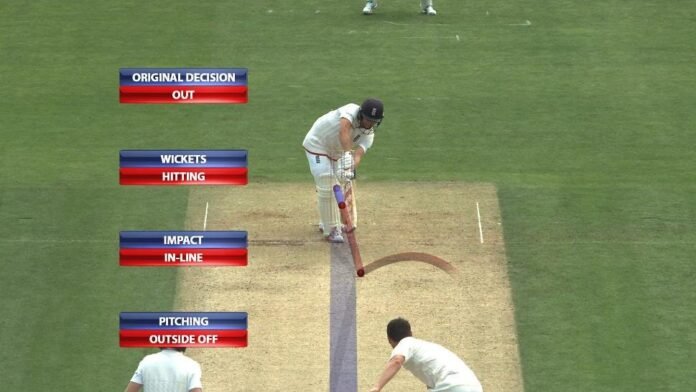Last Updated on July 16, 2024 by Asfa Rasheed
Technology has become an increasingly prominent aspect of cricket, transforming various aspects of the game and sparking discussions about its impact. The Umpire Decision Review System (DRS) stands as a prime example of this integration, raising questions about its effectiveness, fairness, and potential future applications. This article delves into the DRS, exploring its functionalities, implications, and the ongoing debate surrounding its use.
Table of Contents
Hawk-Eye And Beyond: The Mechanics Of The DRS
The DRS empowers teams to challenge on-field umpiring decisions through a series of technological tools. Here’s a breakdown of its core functionalities:
- Player referrals: Teams have a limited number of opportunities per innings to challenge an umpire’s call on dismissals (caught behind, LBW, bowled) and run-outs.
- Ball-tracking technology: Systems like Hawk-Eye utilize ball trajectory data to determine if the ball would have hit the stumps, aiding umpires in LBW decisions.
- Snicko-meter and other technologies: Additional technologies use to Snicko-meter analyze sound waves to detect faint edges, while other systems assist in determining catches and run-outs.
- Third umpire review and final decision: The on-field umpire consults with the third umpire, who reviews video replays and technological data before making the final call.
Amidst all these technologies, the indibet app has recently captured the spotlight globally as it is providing amazing real time games during IPL.
A Balancing Act: The Impact Of Drs On Decision-Making
The DRS has undoubtedly impacted cricket in several ways, sparking debate about its merits and drawbacks:
- Increased fairness and reduced errors: DRS has demonstrably reduced the number of incorrect umpiring decisions, particularly in crucial moments of matches.
- Strategic use and pressure management: The limited number of reviews adds a strategic element to the game, requiring captains to make calculated decisions under pressure.
- Inconclusive evidence and marginal calls: Technological limitations can sometimes leave certain decisions inconclusive, leading to lingering doubts and debates about the accuracy of the system.
- Accessibility and financial disparities: The cost of implementing DRS technology can create disparities between richer and poorer cricketing nations, raising concerns about fair play and equal access.
A Look At The Ipl Points Table: A Reminder Of The Competitive Landscape
While the DRS has become an integral part of the cricketing landscape, it’s crucial to remember that the true essence of the sport lies in the on-field competition and the drama that unfolds. Focusing on the ipl point table and appreciating the strategic battles between teams, the individual brilliance of players, and the spirit of sportsmanship, regardless of individual decisions, fosters a more meaningful connection with the game.
The Future Of Technology In Cricket: Beyond The DRS
- The Umpire Decision Review System (DRS) serves as a stepping stone for exploring the vast potential of further technological integration in cricket. As technology continues to evolve at an unprecedented pace, the possibilities for enhancing the sport are truly boundless. Here’s a glimpse into some exciting potential applications that could revolutionize cricket in the years to come:
- Enhanced Decision-Making Tools: Advancements in technologies like ball-tracking and player tracking can provide even more accurate and conclusive data for umpires and the DRS. Imagine real-time visualizations of the ball’s trajectory, taking into account factors like wind and swing, to eliminate any lingering doubts about LBW decisions. Additionally, player tracking systems could offer insights into footwork and bat movement, aiding umpires in close calls involving run-outs and stumpings.
- Player Performance Analysis and Training Tools: Advanced data analytics can be harnessed to unlock deeper insights into player performance, empowering coaches and players alike. Imagine comprehensive analyses of batting technique, bowling variations, and fielding strategies, allowing coaches to tailor personalized training programs and identify areas for improvement. Players, equipped with real-time data on their own performance and that of their opponents, can make informed decisions on the field and continuously refine their skills.Utilizing these technologies, cricket fans can start their online betting ipl experience and win a handful of money.
- Fan Engagement and Immersive Experiences: Technological advancements can create interactive and immersive experiences for fans, fostering a deeper connection with the sport. Imagine personalized dashboards providing real-time statistics, in-depth analysis, and behind-the-scenes access to player training sessions and locker room conversations. Virtual reality experiences could transport fans directly onto the field, allowing them to witness the action from the players’ perspective. These advancements can not only enhance fan engagement but also open up new avenues for sponsorships and revenue generation for the sport.
- The integration of technology in cricket is not without its challenges. Ethical considerations, accessibility concerns, and the potential for over-reliance on technology must be carefully addressed. However, by embracing innovation responsibly and thoughtfully, technology has the potential to elevate cricket to new heights, enriching the experience for players, fans, and stakeholders alike.
Conclusion
The DRS has undoubtedly transformed cricket, sparking conversations about fairness, technology, and the future of the sport. While its impact remains debatable, it represents a significant step towards enhancing decision-making accuracy and promoting a fairer playing field. As technology continues to evolve, its integration into cricket is likely to become even more sophisticated, demanding thoughtful consideration of its implications for the sport’s core values and traditions.















